Here is a simple method for removing candle wax from glass.
Removing stubborn wax can be a tricky task, but with the right technique, we can have our glass looking crystal clear again. We will guide you step-by-step through the process, ensuring a wax-free result.
First, gather the necessary supplies and then scrape off any excess wax.
Next, we’ll heat the glass and use a hairdryer to melt the remaining wax. Once melted, we can easily wipe away the wax and rinse the glass with clean water.

Afterward, we’ll dry it with a lint-free cloth and give it a final polish with glass cleaner.
Follow these simple steps, and your glass will be wax-free and ready to enjoy!
Key Takeaways
- Use heat to soften the wax for easier removal
- Scrape off the softened wax with a plastic card or blunt knife
- Freeze the wax to harden it and then chip it away with a plastic scraper or credit card
- Soak the glass in hot water to soften the wax and then scrape it off
Gather the Necessary Supplies
First, we’ll gather the necessary supplies to remove candle wax from glass.
To start, you’ll need a hairdryer or a heat gun. These safe heating methods will help soften the wax without causing any damage to the glass.

Additionally, you’ll need a soft cloth or a paper towel to wipe away the melted wax. A plastic scraper or an old credit card can also be helpful in gently scraping off any stubborn residue.
To tackle any remaining wax stains, it’s recommended to have rubbing alcohol or white vinegar on hand. These solutions will effectively remove any leftover residue without harming the glass surface.
Remember to always handle glass objects with care to prevent any accidental damage.
Scrape off Excess Wax
Now, let’s talk about how to scrape off excess wax from glass surfaces.

There are a few methods you can try.
First, you can use heat to soften the wax and then scrape it off using a plastic card or a blunt knife.
Alternatively, you can freeze the wax by placing ice cubes in a plastic bag and then gently chip away the hardened wax.
Lastly, you can pour hot water over the wax to soften it and then scrape it off.

Heat and Scrape
To remove excess wax from glass, we can use heat and a scraper. When using heat to remove wax, it’s important to use safe heating methods to prevent glass damage. One method is to place a towel soaked in hot water onto the wax and let it sit for a few minutes. The heat from the towel will soften the wax, making it easier to scrape off.
Another safe heating method is to use a hairdryer on a low setting to gently heat the wax. Once the wax is softened, use a plastic scraper or a credit card to scrape off the excess wax from the glass surface. By using these safe heating methods and a scraper, we can effectively remove excess wax from glass without causing any damage.
Now, let’s explore another method called ‘freeze and chip’.
Freeze and Chip
We frequently use the freeze and chip method to scrape off excess wax from glass. This method is safe and effective, and it doesn’t require any special tools. All you need is a freezer and a scraping tool, such as a credit card or a plastic spatula.

Here’s how the freeze and chip method works:
- Place the glass object with the wax in the freezer for about 30 minutes. Make sure the wax is completely frozen.
- Take the glass out of the freezer and use a scraping tool to gently chip away the frozen wax. Be careful not to scratch the glass.
- If the wax is stubborn and doesn’t come off easily, you can repeat the freezing process and chip away at it again.
Use Hot Water
After freezing and chipping off the excess wax, our next step is to use hot water to scrape off any remaining residue from the glass. Here’s how to do it:
- Fill a sink or basin with hot water: Make sure the water is at a safe temperature, not too hot to touch.
- Submerge the glass: Place the glass in the hot water, ensuring that the wax-covered area is completely submerged.
- Let it soak: Allow the glass to soak for a few minutes. The heat will soften the wax, making it easier to remove.
- Scrape off the wax: Use a plastic scraper or an old credit card to gently scrape off the softened wax. Be careful not to scratch the glass.
Alternative methods: If hot water doesn’t work, you can also try using a hairdryer to melt the wax or using a commercial wax remover specifically designed for glass surfaces.
Heat the Glass
Now let’s talk about how to safely heat the glass to remove candle wax.

There are a few methods you can use, such as using hot water or a hairdryer.
It’s important to proceed with caution to prevent any damage to the glass, so make sure to follow these safe heating methods.
Safe Heating Methods
To safely heat the glass, we can use a hairdryer or place it in a warm oven. Here are three safe heating methods to consider:
- Hairdryer: Set the hairdryer to a low or medium heat setting and hold it a few inches away from the wax. Move the hairdryer back and forth over the wax until it starts to melt. Use a soft cloth or paper towel to wipe away the melted wax.
- Warm Oven: Preheat the oven to a low temperature, around 150°F (65°C). Place the glass container on a baking sheet and place it in the oven for a few minutes. Keep a close eye on it to prevent overheating. Once the wax has softened, carefully remove the glass from the oven and wipe away the wax.
- Hot Water Bath: Fill a bowl or sink with hot water, but not boiling water. Submerge the glass container in the water, making sure the water level is below the rim. Let it sit for a few minutes until the wax melts. Use a cloth or sponge to wipe away the wax residue.
Preventing Glass Damage
To prevent any potential damage to the glass, we can safely heat it using various methods. One effective way to protect glass surfaces is to heat the glass before attempting to remove the wax. This can be done by using a hairdryer on a low heat setting or by placing the glass in a warm water bath. By gently heating the glass, the wax will soften, making it easier to remove without causing any scratches.
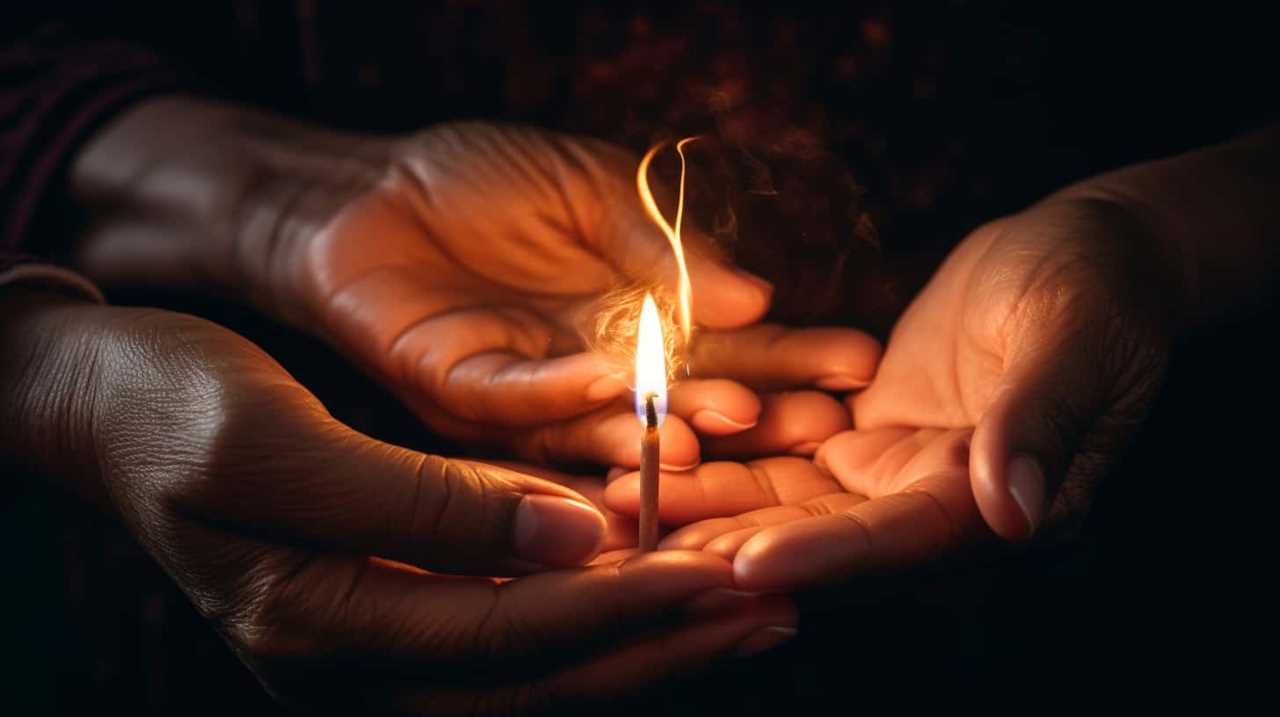
It’s important to take precautions to avoid scratching or damaging the glass surface when removing candle wax. It’s important to avoid using direct heat sources such as open flames or hot water, as these can cause thermal shock and potentially shatter the glass.
Use a Hairdryer to Melt the Wax
We can easily remove candle wax from glass by using a hairdryer to melt it. This method is effective and convenient for melted wax removal.
Here are three reasons why using a hairdryer is a great alternative heating method:
- Quick and efficient: The hot air from the hairdryer melts the wax within seconds, allowing it to be easily wiped away.
- No damage to the glass: Unlike other heating methods, such as using a flame or boiling water, a hairdryer provides gentle heat that won’t crack or damage the glass surface.
- Versatility: A hairdryer can be used on various sizes and shapes of glass, making it a versatile tool for wax removal.
Once the wax is melted, it’s time to move on to the next step: wiping away the melted wax.
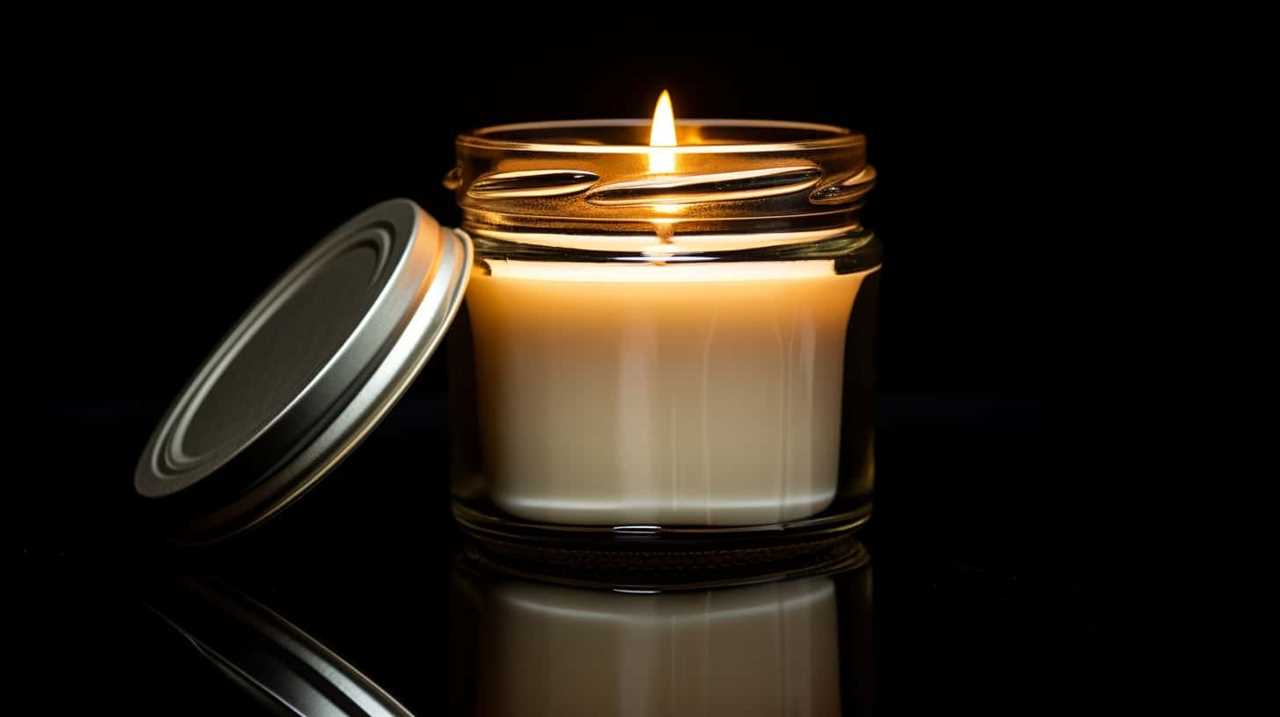
Wipe Away Melted Wax
Now that the wax has been melted, it’s time to wipe it away. There are two effective methods you can try: heat and scrape, or freeze and chip.
With the heat and scrape method, use a cloth or paper towel to wipe away the melted wax while it’s still warm.
For the freeze and chip method, place the glass in the freezer until the wax hardens, then gently scrape it off with a plastic card or your fingernail.
Heat and Scrape
After heating the wax with a hairdryer, we can easily scrape it away from the glass surface. Here are three safe heating methods to consider when removing candle wax from glass to prevent any damage:
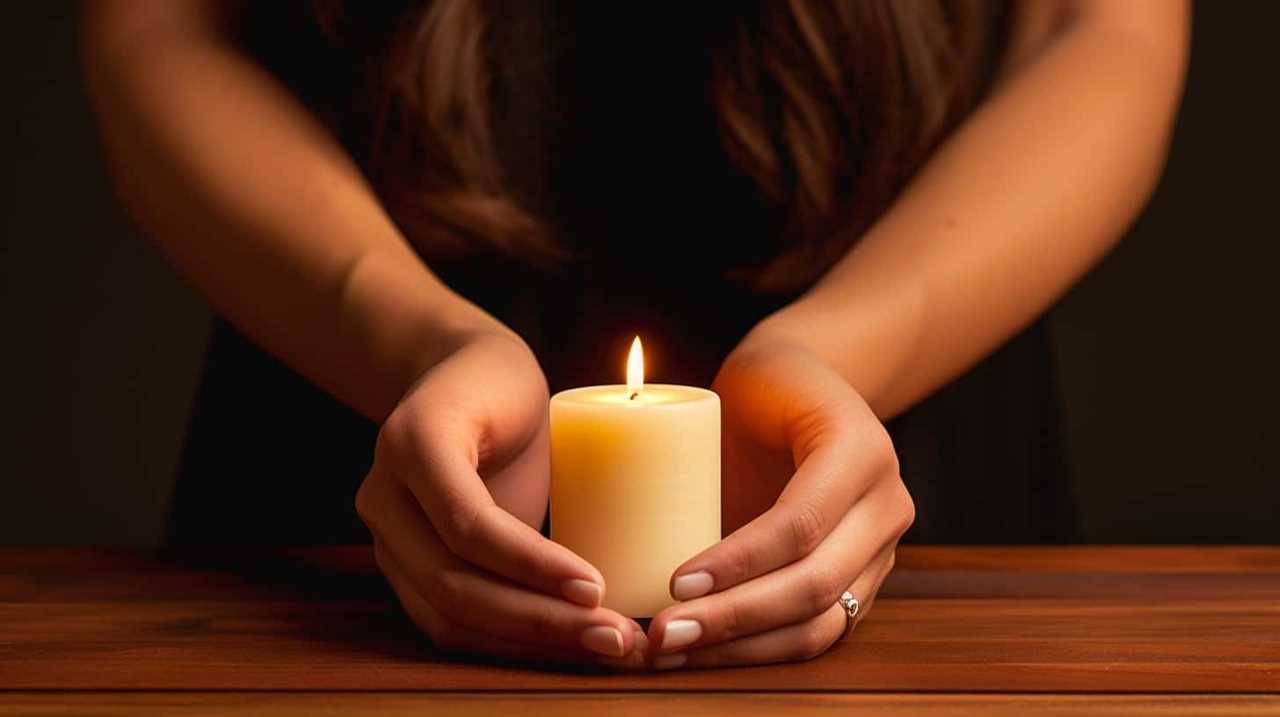
- Use a hairdryer: Set the hairdryer to a low heat setting and hold it a few inches away from the wax. Move the hairdryer back and forth, heating the wax until it starts to melt. Once it has softened, use a plastic scraper or an old credit card to scrape away the melted wax gently.
- Warm water: Fill a basin or sink with warm water and place the glass object inside, ensuring the wax is submerged. Allow the wax to soften for a few minutes, then use a plastic scraper to gently scrape off the wax.
- Oven method: Place the glass object in a cold oven. Set the temperature to the lowest setting and allow the oven to warm up. As the oven warms, the wax will melt and drip off the glass surface. Use caution when removing the glass from the oven and scrape off any remaining wax.
Freeze and Chip
How can we effectively remove melted candle wax from glass using the freeze and chip method?
Freezing the wax is a safe and effective way to harden it, making it easier to remove. To do this, place the glass object in the freezer for a few hours until the wax is completely frozen.
Once frozen, take a plastic scraper or a credit card and gently chip away the wax from the glass surface. Be careful not to scratch the glass while scraping. If the wax is stubborn and doesn’t come off easily, you can try alternative scraping techniques such as using a plastic knife or a rubber spatula. These tools can help loosen the wax without damaging the glass.
Once you have removed as much wax as possible, you can move on to the next step: using a vinegar solution for stubborn stains.

Use a Vinegar Solution for Stubborn Stains
We recommend using a vinegar solution to tackle stubborn stains on glass when removing candle wax. Vinegar is a versatile and effective cleaning agent that can break down the wax and remove any residue left behind. Here are three reasons why a vinegar solution is a great alternative for removing stubborn stains:
- Affordable and readily available: Vinegar is a common household item that can be found in most kitchens. It’s an inexpensive cleaning solution compared to other commercial products.
- Natural and non-toxic: Unlike harsh chemicals, vinegar is a safe and eco-friendly option for cleaning glass surfaces. It doesn’t release any harmful fumes and is gentle on the skin.
- Multipurpose cleaning agent: Vinegar can be used for various cleaning tasks around the house. It not only removes candle wax stains but also helps eliminate odors and disinfects surfaces.
To prepare a vinegar solution, mix equal parts white vinegar and water in a spray bottle. Spray the solution onto the stubborn stain, let it sit for a few minutes, and then wipe it clean with a cloth. Repeat if necessary until the stain is completely removed.
Scrub With a Non-Abrasive Cloth
Now let’s move on to the next step: scrubbing with a non-abrasive cloth.
This is an effective method to remove any remaining wax residue from the glass surface. By using a gentle yet firm motion, we can ensure that the cloth doesn’t scratch or damage the glass.
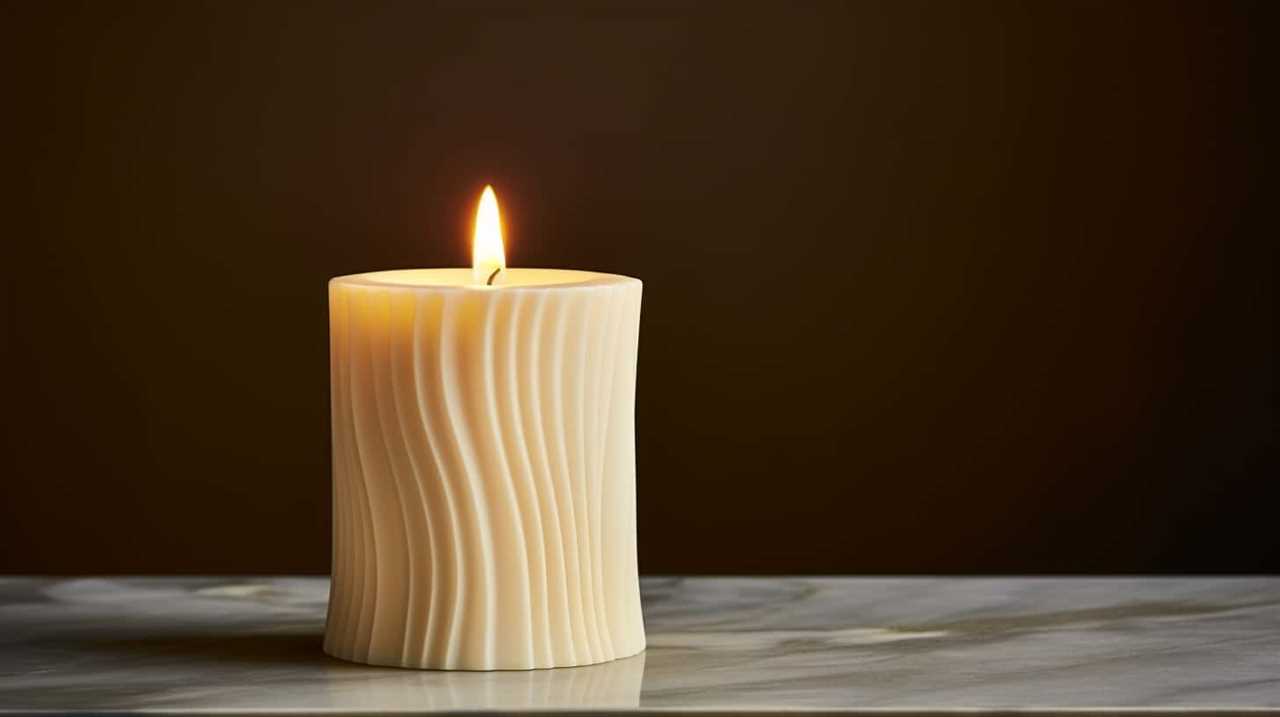
Remember to apply some pressure to target the stubborn wax spots, and continue scrubbing until the glass is clean and smooth.
Heat and Scrape
To effectively remove candle wax from glass, one option is to heat and scrape the wax while scrubbing with a non-abrasive cloth. This method is effective and safe for the glass surface if done correctly. Here are three steps to follow for safe and efficient wax removal:
- Use safe heating methods: Begin by placing the glass object in a sink or basin filled with warm water. Avoid using boiling water, as it may cause thermal shock and crack the glass. Alternatively, you can use a hairdryer on low or medium heat to melt the wax gently.
- Scrape the wax: Once the wax has softened, carefully scrape it off using a plastic scraper or an old credit card. Be gentle to prevent scratching the glass.
- Scrub with a non-abrasive cloth: After removing the majority of the wax, dampen a non-abrasive cloth with warm soapy water and gently scrub the remaining residue. Rinse the glass thoroughly and dry it with a clean cloth.
By following these steps, you can safely remove candle wax from glass without causing any damage.
Now let’s move on to the next method: freeze and chip.

Freeze and Chip
To remove candle wax from glass using the freeze and chip method, we can scrub the residue with a non-abrasive cloth. Freezing the wax helps it harden, making it easier to remove.
There are safe freezing methods you can use to avoid damaging the glass. First, place the glass in a plastic bag and seal it. Then, place it in the freezer for a few hours until the wax becomes brittle.
Once frozen, take the glass out and use a non-abrasive cloth to gently scrub the wax off. If there are any stubborn spots, you can try alternative scraping techniques such as using a plastic scraper or a credit card to carefully chip away the remaining wax.
Remember to be gentle to avoid scratching the glass.

Use Hot Water
To remove candle wax from glass, we can effectively use hot water and scrub the residue with a non-abrasive cloth. Here are three steps to follow in order to achieve the best results:
- Preventive measures: Before lighting a candle, consider placing a glass coaster or a small dish underneath it. This will catch any wax drippings and prevent them from directly adhering to the glass surface.
- Hot water method: Start by filling a sink or basin with hot water. Place the glass item in the water, ensuring that the wax-covered area is fully submerged. Let it sit for a few minutes to allow the wax to soften. Then, take a non-abrasive cloth and gently scrub the softened wax away. Rinse the glass with clean water to remove any remaining residue.
- Alternative methods: If the hot water method doesn’t fully remove the wax, you can try using a hairdryer on a low setting to melt the wax, and then wipe it away with a cloth. Another option is to use rubbing alcohol or vinegar to dissolve the wax, followed by wiping it off with a cloth.
Soak in Warm Soapy Water
We will soak the glass in warm soapy water to remove the candle wax. This method is effective in loosening the wax and making it easier to remove.
To start, fill a sink or basin with warm water and add a few drops of dish soap. Make sure the water isn’t too hot to avoid damaging the glass.
Place the glass in the soapy water and let it soak for about 15-30 minutes. During this time, the warm water and soap will work together to dissolve the wax. For stubborn wax, you can gently scrub the glass with a soft cloth or sponge.
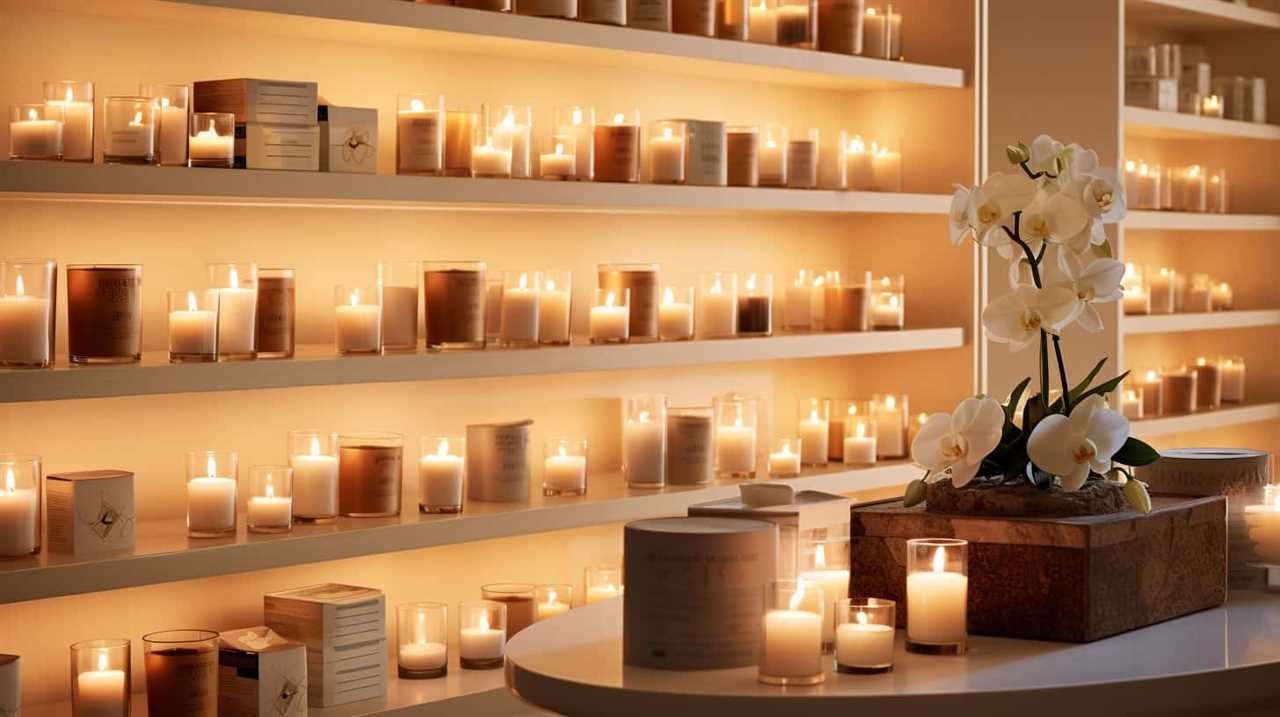
Once the wax is completely removed, rinse the glass with clean water and dry it with a soft towel.
Now, let’s move on to the next section where we’ll learn how to use a baking soda paste for tough stains.
Use a Baking Soda Paste for Tough Stains
How can we effectively use a baking soda paste to tackle tough stains on glass?
Using baking soda paste is a great alternative cleaning method that can help remove stubborn stains from glass surfaces. Here are three benefits of using a baking soda paste for tough stains:
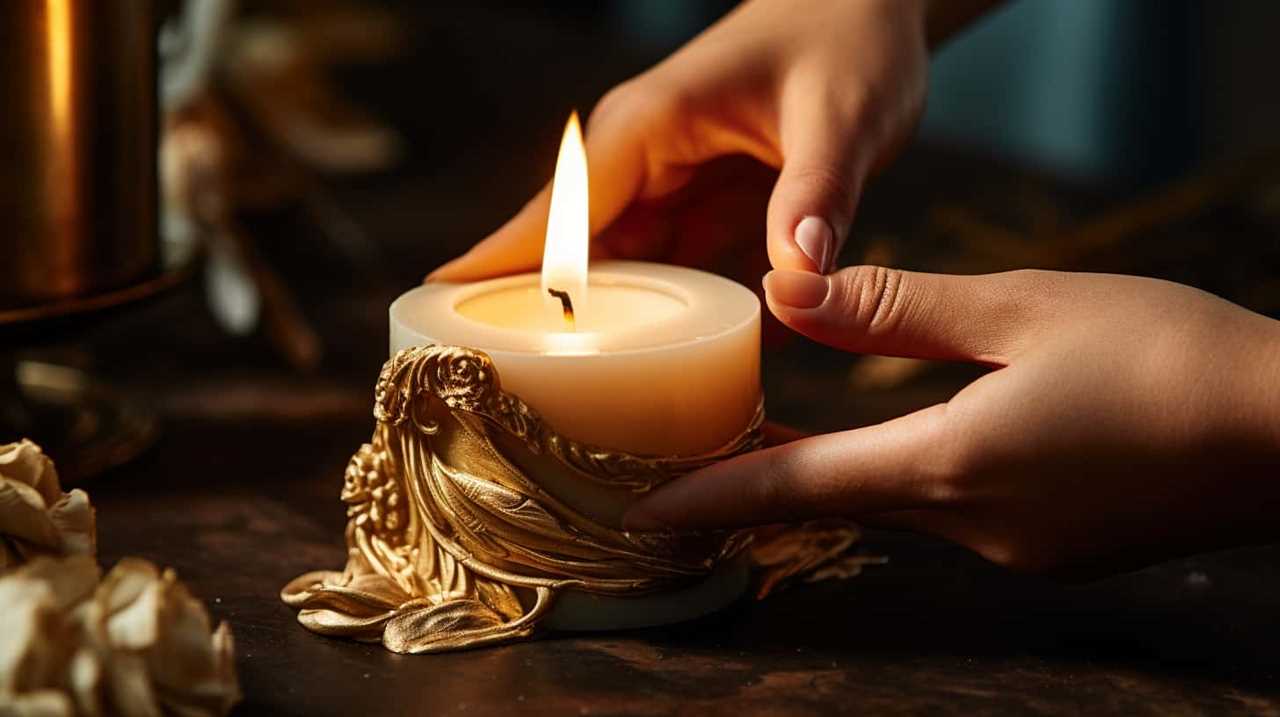
- Mild abrasive properties: Baking soda acts as a gentle abrasive, making it effective in removing tough stains on glass without scratching the surface.
- Versatile cleaning agent: Baking soda can be combined with water to create a paste that can be applied directly to the stained area. This paste can be used to tackle a variety of tough stains, including grease, oil, and mineral deposits.
- Odor neutralizer: In addition to its cleaning properties, baking soda also helps eliminate unwanted odors. This makes it an ideal choice for removing stains caused by spills or accidents that may leave behind unpleasant smells.
Scrub With a Toothbrush
One effective way to tackle tough stains on glass is by using a toothbrush to scrub them away.
When it comes to removing candle residue, a toothbrush can be a handy tool.
Start by dipping the toothbrush in warm, soapy water to moisten the bristles.
Gently scrub the wax-stained glass in circular motions, applying light pressure. The bristles will help to loosen and lift the wax, allowing it to be easily wiped away.
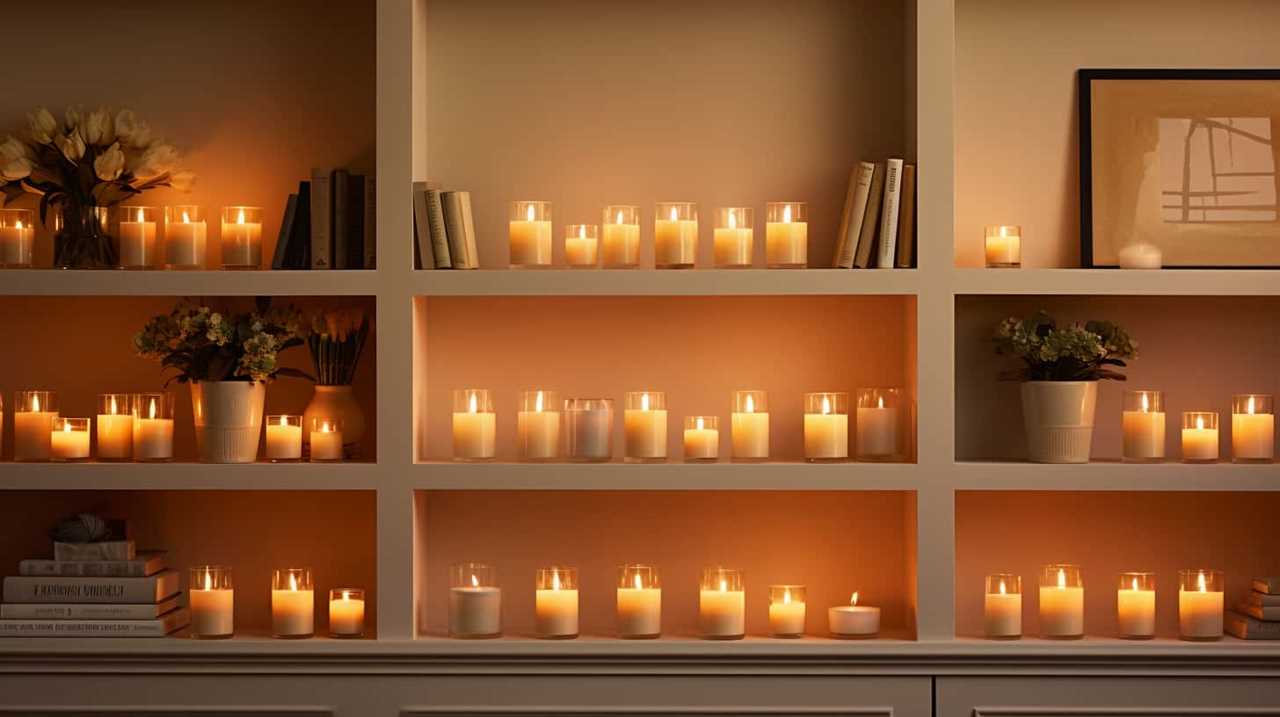
Pay extra attention to any stubborn spots, using the toothbrush to agitate the wax until it breaks apart.
Once you have thoroughly scrubbed the glass, it’s time to move on to the next step: rinsing with clean water.
Rinse With Clean Water
After thoroughly scrubbing the wax-stained glass with a toothbrush, we should rinse it with clean water. Rinsing is an important step in removing candle wax residue from glass surfaces. Here are three rinse techniques you can try:
- Running water: Hold the glass under a stream of warm water, allowing it to flow over the wax residue. The water pressure will help dislodge any remaining wax particles.
- Soaking: Fill a basin or sink with warm water and submerge the glass in it. Let it soak for a few minutes to loosen the wax. Then, use your hands or a soft cloth to gently wipe away any remaining residue.
- Vinegar solution: Mix equal parts of water and white vinegar in a spray bottle. Spray the solution onto the wax-stained glass and let it sit for a few minutes. Rinse off the solution with clean water, and wipe the glass dry with a soft cloth.
These alternative methods can help ensure a thorough rinse, leaving your glass clean and wax-free.

Dry With a Lint-Free Cloth
To ensure a streak-free finish, we should gently dry the wax-free glass with a lint-free cloth. After rinsing the glass with clean water and removing the candle wax residue, it’s important to dry the surface thoroughly.
Using a lint-free cloth is crucial to avoid leaving behind any lint or fibers on the glass. Simply pat the glass dry, making sure to reach all areas. The lint-free cloth will absorb any remaining moisture and leave the glass looking clean and clear.
Once the glass is dry, it will be ready for the final step of the process, which is polishing with a glass cleaner. This will give the glass a sparkling finish and remove any remaining residue or streaks.
Polish With Glass Cleaner
First, we’ll apply a small amount of glass cleaner and polish the wax-free glass using a lint-free cloth.

Here is a simple and effective polish technique to remove any residue and bring back the shine to your glass surface:
- Spray a small amount of glass cleaner directly onto the surface of the glass.
- Use a lint-free cloth to gently rub the glass cleaner in circular motions, focusing on the areas where the wax was previously present.
- Continue polishing until the glass is clean and free from any streaks or residue.
It’s important to note that there are alternative methods to polish glass, such as using white vinegar or rubbing alcohol. However, using a glass cleaner specifically designed for this purpose will often yield the best results.
Remember to always follow the instructions on the glass cleaner bottle and avoid using abrasive materials that could scratch the glass.
Enjoy Your Wax-Free Glass!
We can now appreciate our wax-free glass. By following the steps mentioned earlier, we’ve successfully removed all traces of candle wax from our glass surfaces.
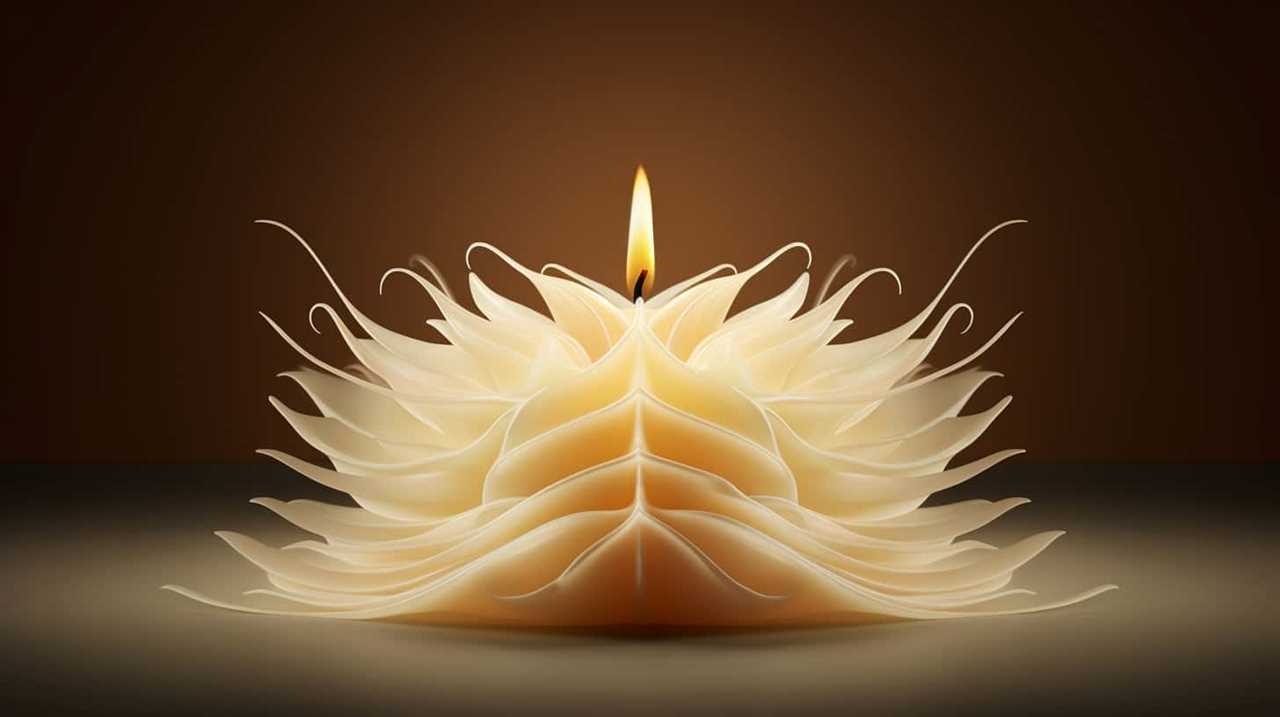
To prevent future wax spills, it’s advisable to use candle holders or trays that can catch any dripping wax. This will ensure that the wax doesn’t come into direct contact with the glass. Additionally, placing a layer of aluminum foil or parchment paper underneath the candle can also help in containing any wax spills.
In case we encounter another wax spill, there are alternative methods for removing wax. One such method is using a hairdryer to melt the wax and then wiping it away with a cloth. Another method is placing the glass in the freezer to harden the wax, making it easier to scrape off.
With these tips, we can maintain our glass surfaces wax-free and enjoy their pristine appearance.
Frequently Asked Questions
Can I Use a Different Heat Source Instead of a Hairdryer to Melt the Wax?
We can use alternative methods for melting candle wax on glass. Using a different heat source, like a heat gun or a microwave, may have its pros and cons compared to using a hairdryer.

How Long Should I Soak the Glass in Warm Soapy Water?
Soaking the glass in warm soapy water is a great way to remove candle wax, but be mindful of how long you soak it. Too much soaking can damage the glass. Consider alternative methods for removing wax if needed.
Can I Use a Different Cleaning Solution Instead of Vinegar for Stubborn Stains?
For stubborn stains on glass, we can try alternative cleaning solutions like baking soda or lemon juice instead of vinegar. These can be effective in removing candle wax and leaving the glass clean and shiny.
How Often Should I Polish the Glass With Glass Cleaner?
We typically clean glass with glass cleaner every week to keep it looking clear and streak-free. It’s best to follow the manufacturer’s instructions and use a soft cloth for optimal results.
Is It Safe to Use a Toothbrush to Scrub the Glass?
Using a toothbrush to scrub glass can be risky as it may cause scratches. We recommend using alternatives like a soft cloth or a plastic scraper to remove candle wax from glass.

Conclusion
And just like that, with a little heat and a few simple steps, you can say goodbye to the stubborn candle wax on your glass.
Imagine the satisfaction of seeing your glass sparkling and wax-free, ready to be enjoyed once again.
So go ahead, gather your supplies, follow the directions, and get ready for the moment of truth.
Your wax-free glass awaits, and you’re just moments away from experiencing the magic of a clean and clear surface.










